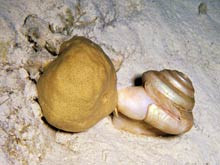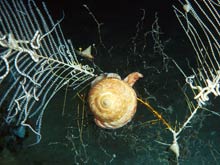
Figure 1. The slit shell, Bayerotrochus midas feeding on a sponge at a depth of 2,500 ft in the Bahamas. Click image for larger view and image credits.
Genetics of Deep-Sea Snails: Geographic Patterns in Their Genes?
Jerry Harasewych, Ph.D.
National Museum of Natural History, Smithsonian Institution
Mollusks are by far the most diverse group of organisms in the sea. There are approximately 150,000 known species of mollusks, compared to less than 5,000 species of corals. Estimates of species of mollusks yet to be discovered, particularly in the deep-sea, exceed one million. The overwhelming majority of mollusks are snails. It should thus come as no surprise that there are far more different kinds of snails living in coral reefs than there are kinds of corals.

Figure 2. The shallowest dwelling slit shell, Entemnotrochus adansonianus, beneath a net-like branching atipatharian coral, and above a group of white solitary corals (Thalamophyllia sp). Click image for larger view and image credits.
Like their shallow water counterparts, deep-sea corals form large and complex ecosystems that provide habitat for, and are populated by, many different organisms. Among the objectives of this cruise is a better understanding of the extent and diversity of the deep reefs of the Straits of Florida. This will include documentation and analyses not only of the species of corals that form these deep reefs, but also of associated organisms including microbes and mollusks. Because snail diversity is much greater than coral diversity, it will likely be possible to discern biogeographic patterns on a finer scale. In doing this research, we will look not only at latitudinal patterns but also patterns associated with depth and topography. A database will be created itemizing the species of snails collected on each dive, including the many minute species sorted from sand and sediment samples.
One group of snails that co-occurs with deep-sea corals throughout this region are the slit-snails, long considered to be "living fossils." These large snails, which range from Bermuda and South Carolina southward to southern Brazil, feed on sponges (Figure 1) , soft corals (Figure 2), stalked crinoids and other organisms along the outermost continental shelf and upper continental slope. Earlier studies have shown that while several species can inhabit the same small geographic area, they never occur together. Instead, different species are found at different depths. Within narrow depth ranges, similar species are separated by longitudinal boundaries and occupy different geographic areas.

Figure 3. The slit shell Perotrochus quoyanus feeding on a soft coral. Click image for larger view and image credits.
Studies of shallow water animals as varied as horseshoe crabs (Limulus polyphemus), oysters (Crassostrea virginica), whelks (Busycon), killifishes (Fundulus species), and diamondback terrapins (Malaclemys terrapin) have revealed genetic discontinuities or barriers with a common geographic location along the central east coast of Florida. There is one group of interbreeding populations to the north of this discontinuity, and another to the south. The latter extends around the tip of Florida and into the Gulf of Mexico. The east Florida Ecotone is an ecological zone or boundary where two ecosystems meet, and it constitutes a significant barrier to gene flow between populations of many shallow water species. One of the goals of this cruise is to investigate if the east Florida ecotone extends into the deeper waters beyond the edge of the continental shelf and divides populations of animals that live along the upper continental slope. Slit shells live at the appropriate depths and form a particularly good model to study gene flow between populations living along the upper continental slope.
DNA will be isolated from a variety of gastropod species, including slit shells, collected throughout the geographic range as well as the range of depths sampled during this expedition. The DNA sequences, or portions of several genes, will be analyzed. Comparing gene sequences will allow us to determine if there are geographic barriers to interbreeding in the deep-sea. Genetic discontinuities from multiple species will be plotted geographically as well as by depth in order to map the east Florida ecotone in three dimensions.
Knowledge about the presence and distribution of barriers to gene flow is important for the management and conservation of deep reefs and their faunas.
























